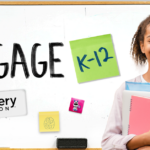By Lindsay Portnoy
What happens when you invite elementary and middle school students along with their teachers, parents, and administrators to co-create solutions the most pressing concerns in their learning space? Perspectives shift, minds expand, and voices carry further than they ever have before.
This fall I visited a thriving learning community in the heart of Brooklyn to enact a design thinking based protocol. At the crossroads of a quickly gentrifying community in Park Slope, Brooklyn, P.S. 282 is undergoing significant transitions. The K to 8 school has recently begun phasing out their middle school to make room for the growing population of children entering elementary school living in their local community.
This transition has elevated latent concerns about the transitioning middle school students and teachers. It also surfaced new opportunities to harness and amplify voices across a diverse population. Using the lens of design thinking educational stakeholders identified the vastly different vantage points presented within the community as opportunities to innovate within a single school building.
Embracing Change and Co-Creating a Shared Future
Building principal Mrs. Amy Rodriguez is a longtime colleague who has spent decades teaching and leading within the New York City Schools. As a newly appointed principal at 282, she embraced the changes as an opening to better understand and define the needs of the entire community.
There is no denying that when individuals are vested in shared goals they are likely to be more intrinsically motivated to work towards creating a solution. But not all approaches towards solving problems invite the voices of every stakeholder into the conversation. Similarly, if individuals have autonomy in the expression of competence through relatedness and connections to the community, you may very well have a recipe for success! The only question remaining is: how can we define a shared goal for the collaborative work ahead at P.S. 282?
Rodriguez invited me to visit the bustling learning space and share my “Reflect, Define, Solve” © Protocol with the community. The goal? To elevate diverse voices of students, caregivers, and educators in the building to bring together distinct views and seed new growth.
The protocol is grounded in the science of learning and motivation and is enacted through the lens of design thinking. More specifically it builds off cognitive research of defining problems as well as motivational research that aims to understand optimal conditions to cultivate learning.
The process of design thinking asks folks to consider multiple perspectives. When used in schools, design thinking ensures that every stakeholder has a voice and that those voices are elevated to co-create the learning we most wish to see.
Shared Language to Move from Problem to Solution
Using the “Reflect, Define, Solve” © Protocol begins with a guiding question that prompts problem identification and ultimately launches into design thinking solutions. At 282 this question is: where is there an opportunity to innovate within our shared learning space?
With a single piece of paper and a marker, crayon, or pen, we began unpacking opportunities to innovate within the community beginning with four essential questions:
- What are three things you love most about 282?
- What is one thing you love least about 282?
- If you had a magic wand, what is one problem at 282 you would solve tomorrow?
- In your opinion, what are three possible reasons for why your problem from Q3 exists?
A think-pair-share invites a quick debrief about the attributes of the space. These attributes couch the problem and list of potential causes for that problem. The difference between a traditional think-pair-share and the reflection here is when participants then contribute another potential cause to their partner’s identified problem.
Most fascinating in this particular work are the different ways community members of varying ages, roles, and experiences identified attributes and defined the problems of their shared space. For instance, parents and educators discuss their love of community and concerns about discipline, whereas students talked about their feelings of connection to their teachers and their concerns around technology use.
On the surface these concerns look distinct, but upon further discussion we find that in defining unique problems often times we’re working on solving the same issues. After a short session of debriefing and contributing potential causes, participants flip over their paper to respond to the second set of questions before launching into the design.
Part two of the “Reflect, Define, Solve”© Protocol moves problems from symptom to root cause and casts a wide net to discover whose voices must be heard to enact change. The next four questions ask:
- What’s the single cause from your Q4 that if addressed might remove the problem from Q3 altogether?
- What individuals need to be involved to help solve this problem?
- Why aren’t those people already involved in solving the problem? Were they invited? Do they know it is a problem?
- What are three big ideas that if created might remove your root cause from Q5?
The second set of questions invites new perspectives and big ideas to bubble to the surface. Those same caregivers and educators who hoped to see shifts in discipline began to discuss ways to support the social-emotional wellbeing of students. Similarly the students identified their power in making changes that would benefit their own school experiences.
A Seat at the Table
During a three-hour collaboration session, students, parents, and educators came together in the school’s library to co-create designed solutions beginning with this protocol and extending into the greater community. Both groups, grown-ups and students, began to see how many voices were required to be at the table in order to affect change. Together they devised plans to meet with additional stakeholders, prepare an anonymous survey to assess student wellbeing, and pull together different groups of students and teachers to facilitate new friendships and new skills for learning.
Grounded in cognitive science and enacted through design thinking, the “Reflect, Define, Solve” Protocol © is the first step in the iterative process of understanding multiple perspectives around shared problems and working together to co-create solutions. Together we enacted the flexibility, patience, and deep understanding necessary to create change in the school community.
Wholly fascinating in this work is the way each stakeholder begins to see problems through the eyes of an ‘other’. Parents were surprised to see their concerns about the decorations on the wall of the classroom were not shared by their children. In fact, students didn’t find the images distracting but instead helpful in recalling last month’s lesson or celebrating their work publicly.
Students were shocked to hear that parents too wanted to see more opportunities for outdoor time. Learners were rightfully delighted to find the support they so needed in advocating for different resources. The students were also thrilled to find allies in advocating for new materials to use during recess.
The solutions developed at this mini hackathon are still underway. What happens to the outdoor space, the community connections, and the curriculum around wellbeing is still very much a work in progress. Yet an important lesson in this shared space is that community efforts are iterative, ongoing, and must involve every voice in the community. If equitable solutions will be addressed, the needs of every community member must be heard in creating shared designs.
Dr. Lindsay Portnoy is a cognitive scientist and Associate Teaching Professor at Northeastern University. A former public school teacher and co-founder of the immersive science learning company Killer Snails, Portnoy writes and researches at the intersection of cognition, assessment for learning, and emerging technology. Her book Designed to Learn: Using Design Thinking to Bring Purpose and Passion to the Classroom was published in November, 2019 by ASCD.
The American Consortium for Equity in Education, publisher of the "Equity & Access" journal, celebrates and connects the educators, associations, community partners and industry leaders who are working to solve problems and create a more equitable environment for historically underserved pre K-12 students throughout the United States.
- American Consortium for Equity in Educationhttps://ace-ed.org/author/admin/
- American Consortium for Equity in Educationhttps://ace-ed.org/author/admin/April 23, 2025
- American Consortium for Equity in Educationhttps://ace-ed.org/author/admin/
- American Consortium for Equity in Educationhttps://ace-ed.org/author/admin/







